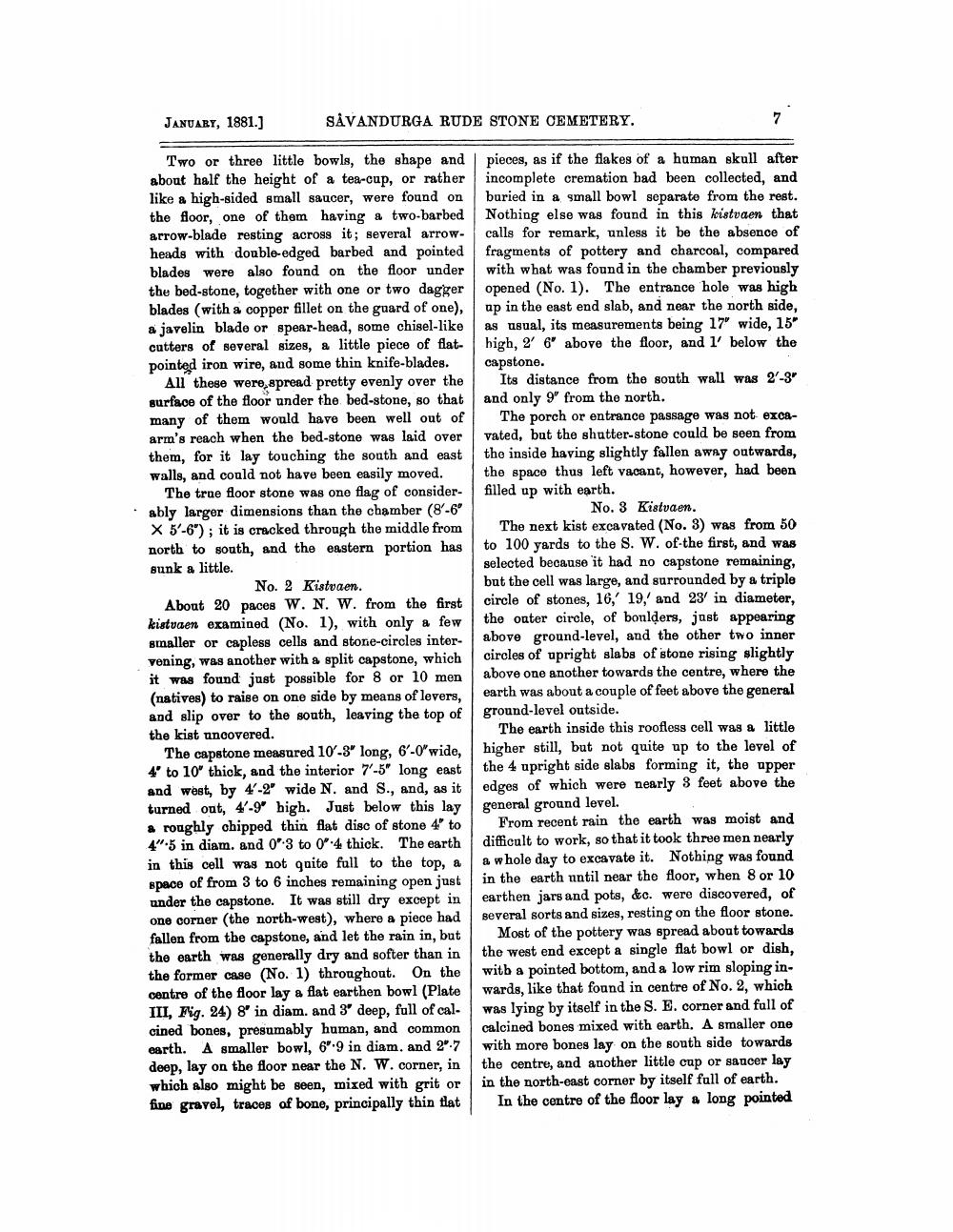________________
SAVANDURGA RUDE STONE CEMETERY.
JANUARY, 1881.]
Two or three little bowls, the shape and about half the height of a tea-cup, or rather like a high-sided small saucer, were found on the floor, one of them having a two-barbed arrow-blade resting across it; several arrowheads with double-edged barbed and pointed blades were also found on the floor under the bed-stone, together with one or two dagger blades (with a copper fillet on the guard of one), a javelin blade or spear-head, some chisel-like cutters of several sizes, a little piece of flatpointed iron wire, and some thin knife-blades.
All these were spread pretty evenly over the surface of the floor under the bed-stone, so that many of them would have been well out of arm's reach when the bed-stone was laid over them, for it lay touching the south and east walls, and could not have been easily moved.
The true floor stone was one flag of considerably larger dimensions than the chamber (8'-6" X 5'-6"); it is cracked through the middle from north to south, and the eastern portion has sunk a little.
No. 2 Kistvaen.
About 20 paces W. N. W. from the first kistvaen examined (No. 1), with only a few smaller or capless cells and stone-circles intervening, was another with a split capstone, which it was found just possible for 8 or 10 men (natives) to raise on one side by means of levers, and slip over to the south, leaving the top of the kist uncovered.
The capstone measured 10'-3" long, 6'-0"wide, 4" to 10" thick, and the interior 7'-5" long east and west, by 4'-2" wide N. and S., and, as it turned out, 4'-9" high. Just below this lay a roughly chipped thin flat disc of stone 4" to 4"-5 in diam. and 0°3 to 0"-4 thick. The earth in this cell was not quite full to the top, a space of from 3 to 6 inches remaining open just under the capstone. It was still dry except in one corner (the north-west), where a piece had fallen from the capstone, and let the rain in, but the earth was generally dry and softer than in the former case (No. 1) throughout. On the centre of the floor lay a flat earthen bowl (Plate III, Fig. 24) 8" in diam. and 3" deep, full of calcined bones, presumably human, and common earth. A smaller bowl, 6.9 in diam. and 2°-7 deep, lay on the floor near the N. W. corner, in which also might be seen, mixed with grit or fine gravel, traces of bone, principally thin flat
7
pieces, as if the flakes of a human skull after incomplete cremation had been collected, and buried in a small bowl separate from the rest. Nothing else was found in this kistvaen that calls for remark, unless it be the absence of fragments of pottery and charcoal, compared with what was found in the chamber previously opened (No. 1). The entrance hole was high up in the east end slab, and near the north side, as usual, its measurements being 17" wide, 15" high, 2' 6" above the floor, and 1' below the capstone.
Its distance from the south wall was 2'-3" and only 9" from the north.
The porch or entrance passage was not excavated, but the shutter-stone could be seen from the inside having slightly fallen away outwards, the space thus left vacant, however, had been filled up with earth.
No. 3 Kistvaen.
The next kist excavated (No. 3) was from 50 to 100 yards to the S. W. of-the first, and was selected because it had no capstone remaining, but the cell was large, and surrounded by a triple circle of stones, 16, 19, and 23' in diameter, the outer circle, of boulders, just appearing above ground-level, and the other two inner circles of upright slabs of stone rising slightly above one another towards the centre, where the earth was about a couple of feet above the general ground-level outside.
The earth inside this roofless cell was a little higher still, but not quite up to the level of the 4 upright side slabs forming it, the upper edges of which were nearly 3 feet above the general ground level.
From recent rain the earth was moist and difficult to work, so that it took three men nearly a whole day to excavate it. Nothing was found in the earth until near the floor, when 8 or 10 earthen jars and pots, &c. were discovered, of several sorts and sizes, resting on the floor stone.
Most of the pottery was spread about towards the west end except a single flat bowl or dish, with a pointed bottom, and a low rim sloping inwards, like that found in centre of No. 2, which was lying by itself in the S. E. corner and full of calcined bones mixed with earth. A smaller one with more bones lay on the south side towards the centre, and another little cup or saucer lay in the north-east corner by itself full of earth.
In the centre of the floor lay a long pointed




